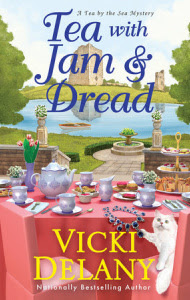by Sheila Connolly
Having
road-tested my choppers (and picked my murder weapon), I am now moving on to
the second-largest group of items in my recent auction haul: the beaters. [Note: if the
history of cookware drives you nuts, just skip ahead to the good part—the
recipe.]
Think back
to watching your mother (or if you were lucky,
your father) make a cake. Cakes were a
big deal in those days, before Betty Crocker et al. took over the universe—I
seem to recall the cooks being very concerned that the cake layers would fall
while baking, so we children had to tiptoe around the kitchen while they were
in the oven, or better yet, go out and play somewhere else. Maybe the ovens were less dependable in those
days, because I don't hear many complaints about fallen cakes nowadays.
Cakes rise while
cooking for only a few reasons: one, you include a leavening agent, like baking
soda or powder or yeast; or two, you beat a lot of air into the batter, so that when
the cake cooks, the air inside the batter expands and voila, the cake swells. Or you combine these techniques.
Now, if you
can, think back to a time when there were no electric mixers, either hand or
stand. You
had to mix things by hand, and that's not easy.
So crafty
manufacturers started making hand-operated mixers that took at least some of
the work out of it. No small number of
them were made of cast iron, which is why they have survived for over a century
(some makers were so proud that they stamped the patent number and the date on
the item itself). And now I have a whole
batch of them, in different designs and sizes.
I decided to see what they can do.
Being of a
scholarly bent, I had to do some research into my wonderful haul,
Fanny Farmer's Butter Cake
This is a
basic and versatile cake. You can add almost anything—chocolate chips, currants
or raisins, honey, cinnamon or nuts.
I made this with no modern appliances (unless you count the oven!)
1 3/4 cups
cake flour
1/2 tsp
salt
2 tsp
baking powder
1/3 cup
butter, softened
1/2 tsp vanilla
1 cup sugar
2 egg yolks
1/2 cup
milk
2 egg
whites
Preheat the
oven to 375 degrees. Grease your pans
(or if you're making cupcakes, you can use paper liners).
Sift the
flour, salt and baking powder.
Cream the
butter thoroughly. Add the vanilla. Add
the sugar gradually and beat until fluffy.
Add the egg yolks.
Stir in
one-half cup of the flour mixture, then one-quarter cup milk, then add the rest
of the flour and milk.
Beat the
egg whites until they are stiff but not dry, then fold them into the batter (by
hand).
 |
| It worked! |
Bake
cupcakes for 20-30 minutes. If you're
making a cake, bake layers as you would the cupcakes; in a loaf pan, bake at
350 degrees for 30-45 minutes.
Oh, and then there's the whipped cream:
 |
| Behold: whipped cream! And fast! |
My final
assessment:
--cooks in
1900 had to work hard!
--they had time to master the
techniques for using the tools, which I didn't
--some of
the tools work better than
others, but the successful ones may not be the ones
you expected
--the cream
whipper worked really well!
--there was
some real pressure to clean up as you went, because if you let metal tools sit,
they rust
It was fun. Will I do it again? Maybe. I still have a few interesting pieces to play with, including a mandoline-like thing that may be for making cole slaw. But it could be hard on unskilled fingers! And a hand-turned rolling pin. And two butter presses--don't you think butter should be pretty?














































The cream whipper looks quite ingenious!
ReplyDeleteGlad to see you having fun with your purchases. I look forward to more installments.
I love your cooking utensils. The recipe looks good. I will have to try it.---Rae
ReplyDeleteAh yes, fifty shades of cakes! Great collection and photos, Sheila. I love your collection.
ReplyDeleteThoroughly enjoying your lessons on our pre-labor-saving-device cooking heritage, Sheila. Wonderful stuff.
ReplyDeleteHave a tasty weekend...
~ Cleo
I'm really enjoying this look back at how our grandmothers baked. I had a great aunt who traveled around as a wedding planner, and I can just imagine her using these sorts of tools.
ReplyDeleteIt might be time to bring that cream whipper back in stainless steel. I do get tired of hauling out the big mixer just to beat a little bit of cream.
~Krista